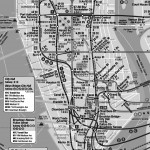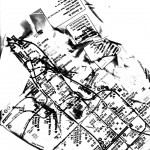Austin stared straight past the Rolos, Snickers, and Skittles at the New York City subway map taped to the newsstand window. When I called to him, he merely blinked and continued tracing the map’s lines with his eyes. I took his hand and tried to pull him down Third Avenue, but he dug in his heels and screeched.
Reaching into my pocket, I fished out two quarters and plonked them on the counter. “Here you go, Columbus,” the vendor joked as he slid Austin a flimsy paper map. “Happy exploring.”
At home, I watched Austin unfold the map on his floor, next to his perfect column of Hot Wheels. Red, green, and orange lines dashed through the map’s ochre boroughs and gray-blue waterways. At the top, in the Bronx, they diffused like a child’s outstretched fingers, curving to their respective termini: Van Cortlandt, Woodlawn, Wakefield, Eastchester, Pelham Bay. Austin gazed hardest at upper Manhattan, where the routes straightened out and were joined by the cobalt A-line. Like many autistic children, Austin has always preferred straight to twisting. Straight is predictable. Straight is safe.

Below 59th Street, south of the mossy rectangle of Central Park, the red, green, orange, and blue routes bisected cross-town yellow, gray, and purple routes in such a jumble Austin had to use his finger to keep himself on track. At Manhattan’s southern tip, the lines extended through the East River, splitting suddenly when they hit Brooklyn’s shore and dispersing inland like capillaries.
The map quickly revealed Austin’s obsessive study habits. The lines became sticky: he had paved them in syrup as he traced their contours over breakfast. The starchy paper wrinkled and ripped: he often slept with the map under his pillow, as if hoping its contents would osmose into his memory. The bottom eighth of the map was torn away: Austin had inadvertently submerged the Upper Bay in real water during a bath.
After a few weeks with the map, Austin knew how to travel from Columbia to NYU, the Financial District to Harlem, and DUMBO to the Upper East Side. He could tell you the 6 train’s every stop, where the F crossed the East River, and the exact street where the 1 merges with the 2 and 3. And yet he had never actually traveled by subway.

Though he has become more flexible, Austin once responded to unexpected situations with the virulence most save for life-threatening emergencies. Abrupt noises led to howls, surprising sights to foot-stomping, and unanticipated contact to head-banging. Exposing Austin to the subway, it seemed, would not be wise. If it wasn’t the blaring jazz bands, the jostling businessmen, or the homeless panhandlers, something was sure to set Austin off.
But one day, Austin and his babysitter, Bara, had no choice. Late for Austin’s therapy appointment, they rushed from our apartment building to find it was pouring and there were no available taxis. Braving the subway was the only sure way to be on time.
As he tiptoed down the slippery steps of the 76th Street station, Austin held Bara’s index finger with his left hand and covered an ear with his right, trying to muffle the din. When they reached the platform, commuters stared as he rhythmically shifted his weight from foot to foot and compulsively clicked his tongue. After a few interminable minutes, the 6 train rolled in and he released Bara’s hand, bursting into a flurry of arm-flapping.
“Calm hands, Austin,” Bara pled. They sidled into the smooth plastic chairs, still warm from their previous occupants, and he continued flailing. As he reached around for a safety belt out of habit (in the subway, there are none), Austin glimpsed something familiar: a huge subway map hanging behind his seat. He faced forward and rested his hands in his lap. Under his breath he muttered the stops he knew came next: 68th Street, 59th Street, 51st Street, Grand Central Station.
“See,” Bara said, more to herself than to Austin. “Not so bad.”
The train jolted out of the station, and a woman holding a cat carrier lunged forward, steadying herself by pressing a wrinkled hand against Austin’s knee. Bara braced for an explosion –—Austin abhorred being touched, even by our mother—but it never came. Instead, he stared blankly at the woman, then calmly turned his gaze back toward the map, his sliver-thin lips pursed in contentment.
He knew where he was going.
Austin’s experience on the subway fueled his fixation with maps. Like a safety blanket, a map had come to mean comfort. Maps made him master of the unforeseen.
After digesting the subway’s 24 lines and 468 stops, he memorized the meandering metropolitan highway system that connects New York City to our grandmother’s nursing home in Rye. By his first visit to Yale, he could instruct me to walk down Chapel Street past College, Temple, Church, Orange, State, and Olive to meet my family at Pepe’s, a pizzeria over a mile from central campus in an area of New Haven I had never explored and he had seen only on a map. After inhaling a mozzarella pie, he navigated as my Dad drove his SUV through the Elm City’s byzantine network of one-way streets back to Route 34.
For the last few years, Austin’s obsession has included imaginary maps. When I come home from school, he insists that we play The Game of LIFE with my middle brother, Jared. He doesn’t fully understand the rules but gleefully plops his plastic station wagon along the serpentine track. He reminds Jared and me to “STOP!” at the red spaces signifying major life events: JOB SEARCH, GET MARRIED, FIND A HOUSE. According to the game’s rule manual, “players must stop on these spots “even if the spin is greater than the number needed to land on them.”
I’m not an expert—in my own life I’ve yet to reach the first of those red squares—but I know that real life doesn’t resemble either a LIFE game board or a subway map. Journeys get derailed, paths change, and there are no scheduled stops. This is particularly true for Austin.
Maybe one day he will experience the rites of passage LIFE demands of its players. Maybe, as he has done in the game, he’ll buy a Victorian mansion, find a wife, and land a job as an airplane mechanic. Or maybe he’ll live with one of us – a small blue action figure in one of our station wagons. We just can’t know. There is no map.

